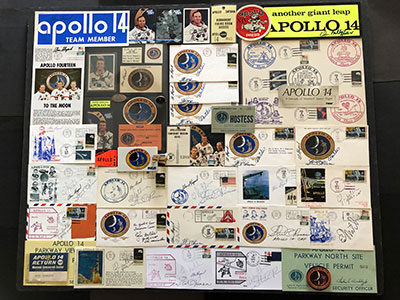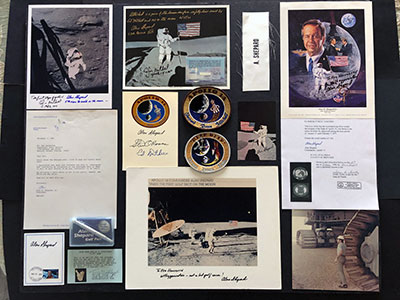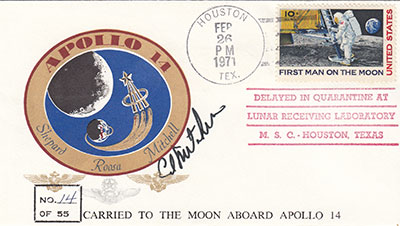 posted 01-29-2021 05:02 PM
posted 01-29-2021 05:02 PM
   
It's hard to believe that it was half a century ago this month (Jan. 31 to Feb. 9, 1971) that our nation's third lunar landing mission took place, Apollo 14, which was the first return to the moon after the nearly-catastrophic Apollo 13 aborted lunar landing spaceflight nine months beforehand.Below is an astrophilately display presentation in celebration of Apollo 14 with mostly crew-signed postal covers and individual astronaut-signed material such as mission covers, badges, cards and decal stickers. It's only a small assortment for this purpose in highlighting some personal Apollo 14 memorabilia, however, there wasn't room enough to depict any signed photos or other non-philatelic material in this montage assembly. Several of the depicted items had been owned/used by Apollo 14's Launch Director Dr. Walter "Kappy" Kapryan, of NASA's Kennedy Space Center in Florida.  The Apollo flight was mostly remembered for the spaceflight return of America's first spaceman, Alan Shepard, but also in him becoming the only "Original 7" astronaut to reach the moon as the world's fifth moonwalker. Even more so, Apollo 14 was probably best known as the "golf ball moon mission." At the end of the second moonwalk (EVA), Apollo 14 commander Al Shepard hit two golf balls with the head of a 6-iron attached to the handle of a lunar-sample collecting tool. One of the balls landed in a crater, making this the first "outer space hole in one." Another, but lesser known sports milestone, was made by Apollo 14 lunar module pilot Ed Mitchell (sixth man to walk on the moon) when he threw an improvised javelin spear," which landed just beyond one of the golf balls. The second montage is a personal one with some flown artifacts and other special memorabilia by Admiral Shepard himself for helping the pioneer Mercury and Apollo astronaut with working on his own space collection evaluations and authentication services.  Shepard and Mitchell explored the lunar highlands for the first time in the Fra Mauro crater region with an on-moon stay time of 33.4 hours on Feb. 5-6, 1971. Their lunar module, LM-8 "Antares," made the most precise lunar landing of the Apollo program with only 87 feet from its targeted point. Apollo 14, the last of the "H" lunar surface landings at specific sites of scientific interest for two-day-long stays with two EVAs, deployed on the surface the third ALSEP experiment package that contained a half-dozen experiments and detectors that included a solar wind collector, a laser ranging retroreflector and Apollo's first active seismic experiment. The EVAs by Shepard and Mitchell were nearly nine and a half hours long that covered a distance of just over two miles. The lunar explorers used on the moon for the first and only time a two-wheeled pull cart, nicknamed the "lunar rickshaw," that could carry and handle just over 20 pounds of tools, equipment, and collected lunar samples. But Apollo 14 was not without major glitches during the nine-day flight. Five docking attempts had to be conducted by command module pilot Stu Roosa until, on the sixth try, a successful "hard dock" was performed in connecting both Apollo spacecraft together before heading out on the three-day trip to the moon. Also, before Antares' powered descent to the lunar surface, there was a short in the lander's computer abort switch, which could have triggered an undesired abort during the LM's descent. The LM pilot had to re-program Antares' computer flight software to ignore the erroneous signal. The software modifications were radioed up to the crew where Mitchell entered the changes just in time for a "go" powered descent landing. Another problem with Antares occurred when the lander's radar failed to lock onto the lunar surface, preventing the computer from being updated with crucial information on altitude and vertical descent speed. The flight controllers at Mission Control in Houston told the pilots to cycle the landing radar breakers; it worked, and once again, just in time. The splashdown of the Apollo command module, CM-110 "Kitty Hawk," on Feb. 9, 1971, occurred within a couple miles of the planned target area, about 800 miles south of American Samoa in the South Pacific Ocean. The recovered command module can now be seen on public display at the Apollo/Saturn V Center at NASA's Kennedy Space Center across the Banana River overlooking the capsule's launch site at Complex 39A. All in all, the astronauts had collected 94 pounds of rock and soil, which would go to 187 scientific teams in the U.S. and 14 other countries for analysis during the decades that followed. One of the rock samples was believed to have actually originated on Earth billions of years ago and possibly landed on the moon from an asteroid impact. After the flight, Shepard said, "We had a fantastic, resounding success on Apollo 14." It was indeed a triumphant return to space for both Shepard and Apollo. | 














